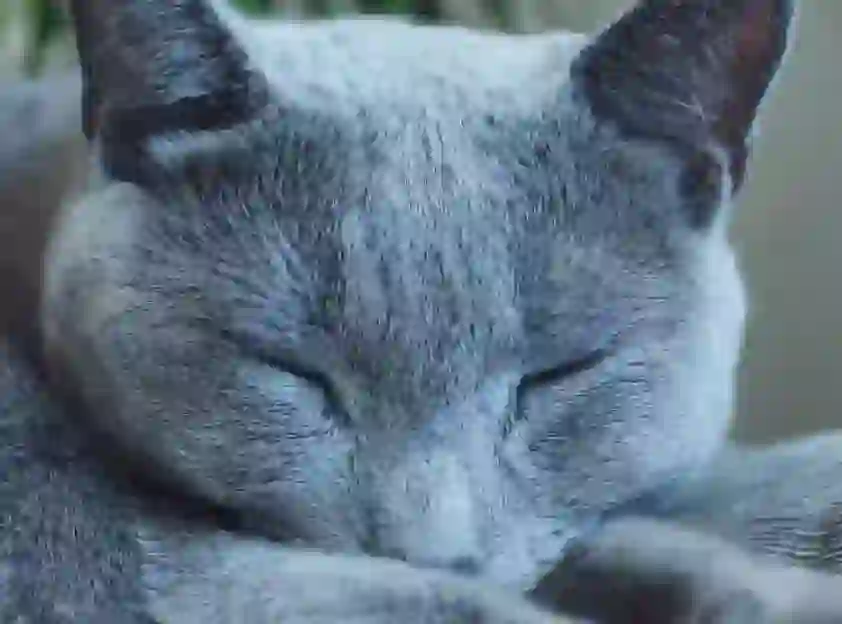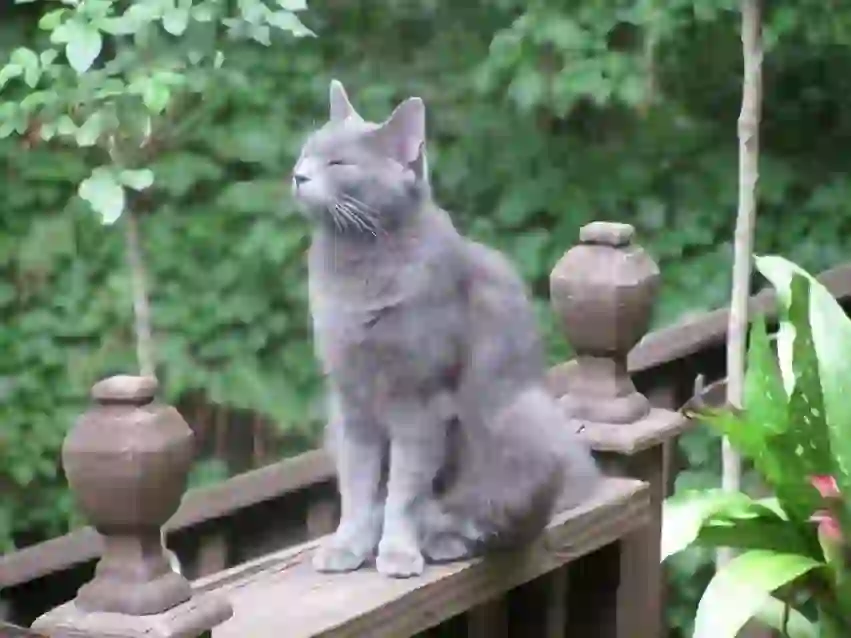
Russian Blue
Russian Blue
Russian Blue
With its luxurious fur and slender, graceful body, the Russian Blue cat is a breed that you may have heard of before. It is one of the most popular breeds that you can find in pet shops. At first glance, it seems to have a calm and cool demeanor that can handle anything, but the Russian Blue cat actually has… a surprising personality hidden behind its appearance!
Russian Blue Basic Infomation

Country of origin Russia.
Length 60cm.
Weight male : 4-5.5kg female : 2.5-5kg.
As the name suggests, it is said that the origin of the breed was a natural occurrence in Arkhangelsk (Archangel) in Russia.
It also had a past where it was called by nicknames such as “Archangel Cat” or “Arkangel Cat”. Its beautiful and noble appearance attracted popularity from the aristocrats.
From around 1860 to the 1880s, it crossed over to England and made its debut at cat shows, where its popularity increased even more.
In the 1900s, it was officially registered as a breed under the name of Russian Blue, but after that, the number of Russian Blues decreased drastically due to the effects of World War II and other factors.
Soon after the war ended, breeders began to breed them to increase the number of Russian Blues, which were on the verge of extinction.
Some people crossbred them with Siamese cats, while others crossbred them with British Shorthairs.
Along the way, they struggled with various problems such as becoming chubby, but eventually they regained their original slender body shape by crossbreeding with Russian Blues that were in England and Scandinavia.
Russian Blue Q&A

Where does Russian Blue get its name?
It became known as the Russian Blue because of its characteristic blue coat and its country of origin, Russia.

What are the color variations of Russian blue?
Only blue.
・Solid color. The entire body, including the face, body, legs and tail, is only one color.
Only green.
Russian Blue is only a short-haired breed.
If you look closely at each hair of the Russian Blue, you will see that there are dark and light parts. This gives the coat a shine and makes it look like waves of light. This is the secret behind why the Russian Blue is said to have a beautiful fur like a carpet.

What does Russian blue look like?
The head shape is wedge-shaped and medium-sized, and the body type is called foreign. The large eyes are slightly slanted and beautiful, and the ears are slightly large for the size of the head, but the base is wide.
The legs are long but moderately toned. It is slender but has moderate muscles, so it has a supple body. The fur is densely covered with fine and short hairs, so it feels soft and smooth, like silk.
The way it walks with its long limbs and small paws gives it a sense of nobility. The tail is also long, so it can be said to be a relatively stylish cat.
The face is also well-proportioned, and the corners of the mouth are slightly raised, making it look like it is smiling. This is called a “Russian smile” and is said to be a unique mouth shape of the Russian Blue.

Why is there only one body color for Russian blue?
There are actually body colors other than blue. The other colors are called white, black, and blue point, but so far only blue is officially recognized as a Russian Blue.

How long does it take to buy Russian Blue?
When keeping animals, you may need to follow the laws set by each country. This time, I will talk about keeping a Russian Blue at home in Japan. If you buy from a breeder or a cattery, it will cost about 200,000 yen. The advantage is that you can check the environment they grew up in and what kind of cats their parents are.
Also, the trustworthiness depends on the personality of the breeder, so it is desirable to visit them after making a reservation.
In the case of pet shops, you can keep the price slightly lower than buying from a breeder, at 100,000 to 150,000 yen. However, some of them may breed indiscriminately, so it may be better to avoid buying from shops that do not clearly state the origin of the breeding.
By the way, here are some of the conditions that cause the price to vary.
・Being a kitten. ・Having excellent bloodlines. ・Although not an official body color, blue point is rare and may be expensive.
There are other conditions as well, but it seems that the price tends to be higher if they meet the above conditions.

I want to know more about the character and characteristics of Russian Blue!
They are loyal to their owners and obediently follow the people who feed them and take good care of them. However, there seems to be a standard among the Russian Blues, and they may ignore and turn away from anyone other than the ones they approve of.
On the other hand, they are jealous and may get angry with jealousy when their owners touch other cats.
They have a cool and beautiful atmosphere and are said to be a bit moody, but they surprisingly have a spoiled side.
So they tend to be affectionate only to the people they approve of. It would be very nice to have a Russian Blue who chooses who to get attached to cuddle up to you.
If anything, males tend to have a more spoiled temperament, and it may be more emphasized after neutering.
On the other hand, females have a “sweet face and cool face both” personality, but after spaying, they may become more spoiled like males.
There are individual differences, but basically Russian Blues who are jealous are not very suitable for keeping multiple cats.
However, it is not impossible, so it is best to consider it after judging what kind of personality the Russian Blue you are keeping has. They also do not like to be bothered too much.
But they seem to be happy when you pet them when they come close to you. They especially love to exercise, and it is important for the health of cats, so it is good to play with them when you find time.
Russian Blue is also called “voiceless cat” and is a cat that does not meow much. Therefore, it can be said that it is an easy breed to keep in apartments or condominiums. However, there are individual differences in personality, so we recommend that you remember it as a reference.
Russian Blue is said to be a breed that is less likely to cause “cat allergies”. These cats are called “hypoallergenic cats”, and other breeds such as “Siberian” and “Bengal” are also hypoallergenic cats. In the case of Russian Blue, it has less glycoprotein, which is the cause of allergies, and as a result, it is less likely to cause allergies.
However, whether or not allergic symptoms occur depends on the individual, so we cannot say for sure that it is absolutely okay. It is only “less likely to cause allergies compared to other cats”, so we recommend that you consult a doctor before keeping one if you have symptoms of cat allergy. ※When keeping animals, you may need to follow the laws established by your country.

What are the diseases that Russian Blue is susceptible to?
Russian Blue is said to have fewer diseases caused by genetic disorders than other breeds.
However, you should be careful about “lower urinary tract disease”, “chronic kidney disease” and “diabetes”.
This is a general term for diseases that all cats are prone to, not just Russian Blue. Specific diseases include “urinary stones” and “cystitis”.
Cats do not have a habit of drinking a lot of water from their ancient times. Therefore, they tend to put a strain on their kidneys and often develop urinary tract diseases.
The fact that the kidneys are prone to strain means that there is also a possibility of developing “chronic kidney disease”. This is a disease in which the kidneys become inflamed due to aging or some other cause, and eventually stop functioning.
To prevent chronic kidney disease, it is desirable to have regular health checkups.
At present, there is no breakthrough treatment, so it is difficult to cure completely, but if you find it early, you can delay the progression by symptomatic treatment.
Also, as a daily measure, you can prevent it by using a circulating type of water dispenser, giving wet type food that contains a lot of water, and not giving too much snacks. Please try to keep these habits in mind.
This disease may be caused by obesity or lack of exercise. In the case of Russian Blue, they have a slim body type, so you can tell by sight if they become obese, but it is also a disease that can be caused by genetics or aging.
You can prevent obesity by keeping your cat in good shape, and you can check if your cat is overweight by using something called “body condition score”. It is good to put them on a scale from time to time and manage their weight.
※Genetic disorders are diseases that occur due to mutations in chromosomes or genes.

What is the lifespan of Russian blue?
The life span of Russian Blue is said to be 10 to 13 years. The average life span of cats is 12 to 16 years, so it is shorter than other cats. However, if you understand what kind of diseases they are prone to and take care of them, there is a good chance that they will live a long life.

Would you like to become a part of the 'Animalbook.jp'?
Turn your knowledge into Q&A and share it with the world. ※Publication will be activated after purchase. Let's share information together!
Russian Blue Type of List

- Russian Blue
Information
Congratulations! You are the first commenter!

Create Your Favorite List!
Russian Blue
Save the animals you love! Build your own list to quickly revisit your favorites later.

Would you like to leave a comment?
※Please note: This is for the purchase of rights to post comments within the article.
Find Your Favorites!
Our shop offers a unique and attractive selection of goods themed around various animals.
Russian Blue References

- まるごとわかる猫種大図鑑 監修:CFA公認審査員 早田由貴子
- 世界中で愛される美しすぎる猫図鑑 監修 今泉忠明
- The Cat Fancier's Association, Inc. https://cfa.org/russian-blue/
- 猫との暮らし大百科 https://www.anicom-sompo.co.jp/nekonoshiori/
- みんなの猫図鑑 https://www.min-nekozukan.com/
- Pet Smile news for ネコちゃん http://psnews.jp/cat/
- 子猫のへや https://www.konekono-heya.com/sitemap.html
- いぬと暮らす、ねこと暮らす。アクサダイレクト https://www.axa-direct.co.jp/pet/pet-ms/detail/5924/
- ねこちゃんホンポ https://nekochan.jp/
- 公益社団法人 埼玉県獣医師会 https://www.saitama-vma.org/topics/猫の遺伝性疾患について/
Russian Blue Introduction of media used

出典:https://pixabay.com/images/id-4670775/

出典:https://unsplash.com/photos/u_lm35U6cUE

出典:https://pixabay.com/images/id-2480773/

出典:https://pixabay.com/images/id-4122353/

出典:https://unsplash.com/photos/NJQkNgL7cLY

出典:https://www.pexels.com/ja-jp/photo/6070504/

出典:https://unsplash.com/photos/nOy-zeBigS8

出典:https://pixabay.com/images/id-762959/

Help Enrich Our Animalbook.jp with Your Media!
We are constantly looking to expand and enrich our Animalbook.jp with amazing photos and videos of animals. If you have any media that you'd like to share, please contribute and help us showcase the beauty and diversity of the animal kingdom. Your submissions will be credited and featured in our encyclopedia, reaching a wide audience of animal lovers.


















